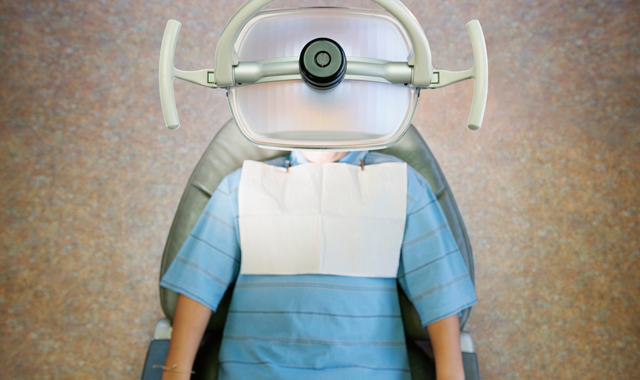New gingivitis code helps you provide ethical care
A new gingivitis code with help you to provide your patients with the full care they deserve.

Our patient presents with moderate generalized inflammation, evidenced by moderate generalized bleeding on probing, with light to moderate supra gingival calculus, light to moderate subgingival deposits, and generalized pseudo pocketing with no radiographic evidence of bone loss. How do you treat this patient, and what code do you use?
In the past, we treated with a prophylaxis (D1110/D1120) because the other treatments available to us were either a full-mouth debridement (D4355) or non-surgical scaling and root planing (D4341/D4342). These treatments are not appropriate for this patient. The full-mouth debridement code is for people who present with heavy, generalized supra-gingival plaque, as well as so many calcified deposits and debris that a comprehensive evaluation is impossible until those deposits are removed. The non-surgical scaling and root planing codes are for those situations where bone loss has occurred, clinical attachment loss can be measured and subgingival removal of deposits is necessary. Our sample patient has none of those conditions.
However, the codes D1110/D1120 are also not appropriate, because those codes are meant for the treatment of a patient with healthy periodontium. These codes have been used for this category of patients simply because we have had no other code that fits. This has caused more harm than we realize.
The problem with incorrect coding
Use of the prophylaxis code and the performance of a routine prophylaxis in the presence of inflammation has given patients and practitioners alike the message that “a little bleeding” isn’t a big deal. The implication is that, until evidence of bone loss exists, disease has not yet occurred. Insurance carriers typically require radiographic evidence of bone loss before they allow benefits for non-surgical periodontal treatment. However, we know that if inflammation presents, even before clinical attachment loss and

bone loss are evident, the result could be a multitude of serious systemic conditions.
Waiting to treat until we can measure attachment and bone loss is problematic in many ways. For one thing, it’s like waiting to treat the patient until end-stage disease. Imagine a physician “watching” a diabetic with out-of-control high blood sugar without medicating or recommending a change in diet until the patient needs a foot amputation. Obviously, this is unethical and dangerous. Yet, we see this watching and waiting in dentistry all the time. If we find an incipient spot of decay, we can ethically choose to not restore the cavity yet. But that doesn’t mean we won’t do something to prevent the spread of decay. We at least apply fluoride in the form of a varnish or silver diamine fluoride.
Related article: 6 ways to ethically persuade a reluctant patient to follow a treatment plan
With gingivitis, watching and waiting is even more prevalent and, without intervention of some type, it is as unethical as the example of the diabetic patient. Yet it occurs daily in practices all across the country, in part because we have not had an appropriate code to accurately describe the condition and the treatment of gingivitis. We can refine the treatment of this patient category by simply having an appropriate code to recognize the distinction between preventive care for healthy patients and therapeutic care for patients with gingivitis.
At the very least, we should make the gingivitis patient aware of the condition and recommend interventions that could potentially halt and reverse the progression of disease. Improved home care routines for those in the earliest stages of disease can sometimes be all it takes to eliminate inflammation. Therefore, patient education is vital. If someone has no idea they have an infectious disease that can affect not only their mouth, but also their entire body, how can we expect them to do something about it? It’s our professional responsibility to inform the patient of the presence of oral inflammation and to fully explain the connection of the pathogenic bacteria with other diseases and conditions they are at risk for, or may already have.
Prevent more infections: 5 infection control mistakes you may be making and not even realize
Up next: The new code and what it means for your patients
Caring for your patient
An ever-growing body of evidence confirms that inflammation anywhere in the body is a significant factor in many chronic diseases such as cardiovascular disease, diabetes, Alzheimer’s disease, pregnancy complications and cancers. In fact, Dr. Bradley Bale and Dr. Amy Doneen recently published research proving that periodontal bacteria are causal for cardiovascular disease. It is our duty to make our patients aware that the mouth is one of the most abundant sources of inflammation in the body, and that treatment to eliminate oral inflammation has beneficial effects on systemic health. By focusing on treating moderate to severe gingivitis, we can prevent or improve a multitude of systemic conditions. This is why the new CDT code for care of moderate to severe gingival inflammation is so important.
Related: The 5 biggest misconceptions about imaging coding and reimbursement
The new code
The new code, D4346, reads "scaling in presence of generalized moderate or severe gingival inflammation-full mouth, after oral evaluation."
The descriptor reads as follows:
The removal of plaque, calculus, and stains from supra- and sub-gingival tooth surfaces when there is generalized moderate or severe gingival inflammation in the absence of periodontitis. It is indicated for patients who have swollen, inflamed gingiva, generalized suprabony pockets, and moderate to severe bleeding on probing. Should not be reported in conjunction with prophylaxis, scaling and root planing, or debridement procedures.
To use this code properly, determine if inflammation is localized or generalized. You must find greater than 30 percent inflamed sites in order to use D4346 accurately. The ADA and AAP suggest documenting using the Löe and Silness gingival inflammation index:
- Type 0: No inflammation
- Type 1: Mild inflammation-slight change in color and slight edema, but no bleeding on probing
- Type 2: Moderate inflammation-redness, edema and glazing, bleeding on probing
- Type 3: Severe inflammation-marked redness and edema, ulceration with tendency to spontaneous bleeding
Read more: 5 important facts about new code D4346 for a fresh start in 2017
What this means for you and your patients
The diagnosis is the most important step in the hygiene evaluation. Never pick up a scaler until you’ve completed a thorough exam for every patient at every appointment. Complete a health history review, collect vital signs and appropriate radiographs, perform a head and neck cancer examination, and perform a full-mouth periodontal charting before beginning any treatment. Determine the appropriate procedure for that person at that time, even if you have always performed just a prophylaxis in the past. Now that we have a gingivitis code, there will be many patients for whom the new code will be appropriate and for whom you will alter the treatment from the routines of the past.